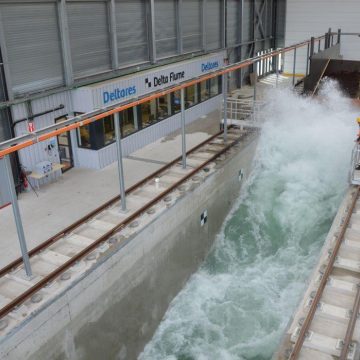New Delta-lab accelerates applied research into soil, water, energy and climate
The energy transition, cleaner water, healthy soils and less greenhouse gases: the Netherlands is facing far-reaching challenges. Meeting them requires an in-depth understanding of exactly what is happening in our soil and our water. In the Delta-lab at Deltares in Delft, which opened today, experts look at how pollutants behave on a microscopic level, how greenhouse gases are released from wet soils and the effect of sustainable energy generation on groundwater and soil.

Natural resources are precious and we must therefore be extremely careful in how we use them. The awareness of the urgency of this issue is increasing, as is the need for solutions. “If we want to accelerate the energy transition and the recovery of soil and water, we need to know exactly what is happening on a microscopic level. For example, we have to understand how bacteria react to pollutants, how rust forms on metal structures in salt water and how gases such as methane are released from wet soils,” says Fredericke Hannes, the head of the Delta-lab.
“The studies take place here in the laboratory at a detailed level, and they are then put into practice in the form of field trials.”
Five main themes
The lab focuses on five themes:
- Anthropogenic (man-made) substances such as PFAS, pharmaceutical residues and microplastics
- Nutrients, including nitrogen and phosphate, and water quality
- Greenhouse gas emissions from wet soils and water
- Mud dynamics and reusing dredged material
- Energy transition and infrastructure, such as the impact of geothermal heat and hydrogen storage
With the brand new greenhouse gas facility in the Delta-lab, we now have, along with other applied research organisations and national knowledge institutes, a state-of-the-art facility
Annemieke Nijhof, Deltares general director
Working without oxygen
Land subsidence, algae growth, the formation of marsh gas in ditches or the spread of PFAS: these are all combinations of chemical, physical and biological processes that the experts in the Delta-lab can study. Most of the processes in our environment take place in the soil. Many micro-organisms that live there die when exposed to oxygen.
In the lab, we can work without oxygen, which allows us to study precisely these subsurface micro-organisms. The lab uses a variety of arrays to simulate the outside world: from aquariums with fresh and salt water to soils with plants or mud from which greenhouse gases can be released.
Come join us at the Delta-lab
Knowledge about greenhouse gases
In addition to Deltares, the Delta-lab is also available for research questions from other knowledge institutes, laboratories and governments.
Annemieke Nijhof, the Deltares general director, is proud of the new lab. “With the brand new greenhouse gas facility in the Delta-lab, we now have, along with other applied research organisations and national knowledge institutes, a state-of-the-art facility. That was possible thanks to a contribution from the Ministry of Economic Affairs. In this facility for the whole of the Netherlands, we are working with partners to develop more knowledge about the greenhouse gases released when we intervene in our water and soil systems. Examples include knowledge about lowering groundwater levels, applying wet crops, reusing dredged material or building infrastructure in peatlands.”
Johan Remkes (Chair of the Deltares Supervisory Board), Jan Hendrik Dronkers (Secretary-General of Ministry of Infrastructure and Water Management) and Jaap Slootmaker (Water and Soil Director-General of the Ministry of Infrastructure and Water Management) opened the lab.

Johan Remkes emphasises: "Physical, chemical and biological issues are increasingly becoming the focus of public attention, and rightly so. The Delta-lab is more than just a building. It is an investment in knowledge, collaboration and social impact. The lab does not belong to Deltares alone, but to our entire Dutch knowledge infrastructure and will serve as a foundation for the coming years: for research, innovation and policy development."
Jan Hendrik Dronkers: "The new Delta-Lab is a breeding ground for knowledge and contributes to the solid foundation of facts and coherence. This is desperately needed to improve the resilience of our delta."
Three heat pumps
The laboratory was built with sustainable materials, it uses geothermal heat and it is located on the Deltares campus in Delft. The 1,600 square metres of gross surface area are heated with an ATES system and three heat pumps. The ventilation rate is 24,000 m3 air/hour.
This is essential because environment-alien and volatile substances are also used in the laboratory. The building has been designed on flexible lines, making it easy to adapt to new research requirements. The sustainable bamboo outer wall contains nesting areas for birds and bats.
Video Delta-lab
In the video below, our experts give you a glimpse into the Delta-lab.
You have not yet indicated whether you want to accept or reject cookies. This means that this element cannot be displayed.
Or go directly to:
Deltares facilities
In addition to the Delta-lab, we have several specialised research facilities on our campus in Delft, such as the Delta Flume, a 300-metre-long wave flume that allows us to analyse the effects of extreme waves on flood defences.
Or the GeoCentrifuge, which makes it possible to study scale models of dykes, tunnels, roads and foundations under increased gravity and time acceleration.
These facilities support Deltares' practical research into safe and future-proof solutions for water and soil issues.




